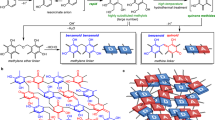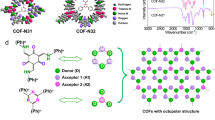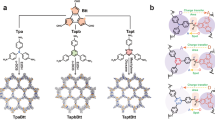Abstract
Artificial photosynthesis is a critical challenge in moving towards a sustainable energy future. Photocatalytic generation of hydrogen peroxide from water and dioxygen (H2O + \(\frac{1}{2}\)O2 → H2O2, ΔG° = 117 kJ mol–1) by sunlight is a promising strategy for artificial photosynthesis because H2O2 is a storable and transportable fuel that can be used directly for electricity generation. All previously reported powder photocatalysts, however, have suffered from low efficiency in H2O2 generation. Here we report that resorcinol–formaldehyde resins, widely used inexpensive polymers, act as efficient semiconductor photocatalysts to provide a new basis for H2O2 generation. Simple high-temperature hydrothermal synthesis (~523 K) produces low-bandgap resorcinol–formaldehyde resins comprising π-conjugated and π-stacked benzenoid–quinoid donor–acceptor resorcinol couples. The resins absorb broad-wavelength light up to 700 nm and catalyse water oxidation and O2 reduction by the photogenerated charges. Simulated sunlight irradiation of the resins stably generates H2O2 with more than 0.5% solar-to-chemical conversion efficiency. Therefore, this metal-free system shows significant potential as a new artificial photosynthesis system.
This is a preview of subscription content, access via your institution
Access options
Access Nature and 54 other Nature Portfolio journals
Get Nature+, our best-value online-access subscription
$29.99 / 30 days
cancel any time
Subscribe to this journal
Receive 12 print issues and online access
$259.00 per year
only $21.58 per issue
Buy this article
- Purchase on Springer Link
- Instant access to full article PDF
Prices may be subject to local taxes which are calculated during checkout





Similar content being viewed by others
Data availability
All experimental data within the Article and its Supplementary Information are available from the corresponding author upon reasonable request.
References
Hisatomi, T., Kubota, J. & Domen, K. Recent advances in semiconductors for photocatalytic and photoelectrochemical water splitting. Chem. Soc. Rev. 43, 7520–7535 (2014).
Jia, J. et al. Solar water splitting by photovoltaic-electrolysis with a solar-to-hydrogen efficiency over 30%. Nat. Commun. 7, 13237 (2016).
Walter, M. G. et al. Solar water splitting cells. Chem. Rev. 110, 6446–6473 (2010).
Kudo, A. & Miseki, Y. Heterogeneous photocatalyst materials for water splitting. Chem. Soc. Rev. 38, 253–278 (2009).
Maeda, K. et al. Photocatalyst releasing hydrogen from water. Nature 440, 295 (2006).
Kubota, J. & Domen, K. Photocatalytic water splitting using oxynitride and nitride semiconductor powders for production of solar hydrogen. Electrochem. Soc. Interface 22, 57–62 (2013).
Sasaki, Y., Nemoto, H., Saito, K. & Kudo, A. Solar water splitting using powdered photocatalysts driven by Z-schematic interparticle electron transfer without an electron mediator. J. Phys. Chem. C 113, 17536–17542 (2009).
Reijnders, L. & Huijbregts, M. Biofuels for Road Transport: A Seed to Wheel Perspective (Springer, 2009).
Wang, Q. et al. Scalable water splitting on particulate photocatalyst sheets with a solar-to-hydrogen energy conversion efficiency exceeding 1%. Nat. Mater. 15, 611–615 (2016).
Fukuzumi, S. Production of Lliquid Ssolar Ffuels and Ttheir Uuse in fuel cells. Fuel Cells. Joule 1, 689–738 (2017).
Fukuzumi, S., Lee, Y. M. & Nam, W. Solar-driven production of hydrogen peroxide from water and dioxygen. Chem. Eur. J. 24, 5016–5031 (2018).
Teranishi, M., Naya, S. & Tada, H. In situ liquid phase synthesis of hydrogen peroxide from molecular oxygen using gold nanoparticle-loaded titanium (iv) dioxide photocatalyst. J. Am. Chem. Soc. 132, 7850–7851 (2010).
Kato, S., Jung, J., Suenobu, T. & Fukuzumi, S. Production of hydrogen peroxide as a sustainable solar fuel from water and dioxygen. Energy Environ. Sci. 6, 3756–3764 (2013).
Moon, G.-H. et al. Solar production of H2O2 on reduced graphene oxide–TiO2 hybrid photocatalysts consisting of earth-abundant elements only. Energy Environ. Sci. 7, 4023–4028 (2014).
Kaynan, N., Berke, B. A., Hazut, O. & Yerushalmi, R. Photocatalytic production of hydrogen peroxide from water and molecular oxygen. J. Mater. Chem. A 2, 13822–13826 (2014).
Kim, H., Kwon, O. S., Kim, S., Choi, W. & Kim, J.-H. Harnessing low energy photons (635 nm) for the production of H2O2 using upconversion nanohybrid photocatalysts. Energy Environ. Sci. 9, 1063–1073 (2016).
Wang, X. et al. A metal-free polymeric photocatalyst for hydrogen production from water under visible light. Nat. Mater. 8, 76–80 (2009).
Shiraishi, Y. et al. Sunlight-driven hydrogen peroxide production from water and molecular oxygen by metal-free photocatalysts. Angew. Chem. Int. Ed. 53, 13454–13459 (2014).
Kofuji, Y. et al. Graphitic carbon nitride doped with biphenyl diimide: efficient photocatalyst for hydrogen peroxide production from water and molecular oxygen by sunlight. ACS Catal. 6, 7021–7029 (2016).
Kofuji, Y. et al. Carbon nitride–aromatic diimide–graphene nanohybrids: metal-free photocatalysts for solar-to-hydrogen peroxide energy conversion with 0.2% efficiency. J. Am. Chem. Soc. 138, 10019–10025 (2016).
Kofuji, Y. et al. Mellitic triimide-doped carbon nitride as sunlight-driven photocatalysts for hydrogen peroxide production. ACS Sustain. Chem. Eng. 5, 6478–6485 (2017).
Ong, W. J., Tan, L. L., Ng, Y. H., Yong, S. T. & Chai, S. P. Graphitic carbon nitride (g-C3N4)-based photocatalysts for artificial photosynthesis and environmental remediation: are we a step closer to achieving sustainability? Chem. Rev. 116, 7159–7329 (2016).
Cheng, Y.-J., Yang, S.-H. & Hsu, C.-S. Synthesis of conjugated polymers for organic solar cell applications. Chem. Rev. 109, 5868–5923 (2009).
Marszalek, T., Li, M. & Pisula, W. Design directed self-assembly of donor–acceptor polymers. Chem. Commun. 52, 10938–10947 (2016).
Fan, X. et al. Construction of graphitic C3N4-based intramolecular donor–acceptor conjugated copolymers for photocatalytic hydrogen evolution. ACS Catal. 5, 5008–5015 (2015).
Li, L., Lo, W., Cai, Z., Zhang, N. & Yu, L. Donor–acceptor porous conjugated polymers for photocatalytic hydrogen production: the importance of acceptor comonomer. Macromolecules 49, 6903–6909 (2016).
Pekala, R. W. Organic aerogels from the polycondensation of resorcinol with formaldehyde. J. Mater. Sci. 24, 3221–3227 (1989).
ElKhatat, A. M. & Al-Muhtaseb, S. A. Advances in tailoring resorcinol–formaldehyde organic and carbon gels. Adv. Mater. 23, 2887–2903 (2011).
Liu, L. et al. Extension of the Stöber method to the preparation of monodisperse resorcinol–formaldehyde resin polymer and carbon spheres. Angew. Chem. Int. Ed. 50, 5947–5951 (2011).
Wagner, W. & Pruss, A. International equations for the saturation properties of ordinary water substance. revised according to the international temperature scale of 1990. Addendum to J. Phys. Chem. Ref. Data 16, 893 (1987). J. Phys. Chem. Ref. Data 22, 783–804 (1993).
Zhao, J. et al. A template-free and surfactant-free method for high-yield synthesis of highly monodisperse 3-aminophenol-formaldehyde resin and carbon nano/microspheres. Macromolecules 46, 140–145 (2013).
Durairaj, R. B. Resorcinol, Chemistry, Technology and Applications (Springer, 2005).
Fries, K. & Brandes, E. Zur Kenntnis der Chinonmethide. Liebigs Ann. Chem. 542, 48–77 (1939).
Hultzsch, K. Studien auf dem Gebiet der Phenol‐Formaldehyd‐Harze, II: Chinonmethide als Zwischenprodukte bei der Phenolharz‐Härtung. Ber. Dtsch Chem. Ges. 74, 898–904 (1941).
Li, T., Cao, M., Liang, J., Xie, X. & Du, G. Mechanism of base-catalyzed resorcinol–formaldehyde and phenol–resorcinol–formaldehyde condensation reactions: a theoretical study. Polymers 9, 426 (2017).
Mulik, S., Sotiriou-Leventis, C. & Leventis, N. Time-efficient acid-catalyzed synthesis of resorcinol-formaldehyde aerogels. Chem. Mater. 19, 6138–6144 (2007).
Kim, M. G., Amos, L. W. & Barnes, E. E. Investigation of a resorcinol–formaldehyde resin by C-NMR spectroscopy and intrinsic viscosity measurement. J. Polym. Sci. A 31, 1871–1877 (1993).
Šebenik, A., Osredkar, U. & Vizovišek, I. Study of the reaction between resorcinol and formaldehyde. Polymer 22, 804–806 (1981).
Egorin, A. M. et al. Effect of parameters of thermal treatment of resorcinol–formaldehyde resins on their chemical stability and 137Cs uptake efficiency. J. Radioanal. Nucl. Chem. 304, 281–286 (2015).
Liebscher, J. et al. Structure of polydopamine: a never-ending story? Langmuir 29, 10539–10548 (2013).
Valle, M. A. et al. Electropolymerization of N-vinylcarbazole in the presence of galvinoxyl. Polym. Bull. 57, 321–328 (2006).
Kuroda, S., Noguchi, T. & Ohnishi, T. Electron nuclear double resonance observation of π-electron defect states in undoped poly(paraphenylene vinylene). Phys. Rev. Lett. 72, 286–289 (1994).
Grimme, S. Semiempirical GGA-type density functional constructed with a long-range dispersion correction. J. Comput. Chem. 27, 1787–1799 (2006).
Janiak, C. A critical account on π–π stacking in metal complexes with aromatic nitrogen-containing ligands. J. Chem. Soc. Dalton Trans. 21, 3885–3896 (2000).
Jeffrey, G. A. An Introduction to Hydrogen Bonding (Oxford Univ. Press, 1997).
Hill, R. M. Hopping conduction in amorphous solids. Philos. Mag. 24, 1307–1325 (1971).
Gordon, I. et al. Editorial. Sol. Energy Mater. Sol. Cells 133, A1–A6 (2015).
Shiraishi, Y. & Hirai, T. Selective organic transformations on titanium oxide-based photocatalysts. J. Photochem. Photobiol. C 9, 157–170 (2008).
Mase, K., Yoneda, M., Yamada, Y. & Fukuzumi, S. Efficient photocatalytic production of hydrogen peroxide from water and dioxygen with bismuth vanadate and a cobalt(ii) chlorin complex. ACS Energy Lett. 1, 913–919 (2016).
Slattery, R. A. & Ort, D. R. Photosynthetic energy conversion efficiency: setting a baseline for gauging future improvements in important food and biofuel crops. Plant Physiol. 168, 383–392 (2015).
Sugano, Y. et al. Supported Au–Cu bimetallic alloy nanoparticles: an aerobic oxidation catalyst with regenerable activity by visible-light irradiation. Angew. Chem. Int. Ed. 52, 5295–5299 (2013).
Liu, Y., Quan, X., Fan, X., Wang, H. & Chen, S. High-yield electrosynthesis of hydrogen peroxide from oxygen reduction by hierarchically porous carbon. Angew. Chem. Int. Ed. 54, 6837–6841 (2015).
Toma, F. M. et al. Efficient water oxidation at carbon nanotube–polyoxometalate electrocatalytic interfaces. Nat. Chem. 2, 826–831 (2010).
Hirakawa, H., Hashimoto, M., Shiraishi, Y. & Hirai, T. Photocatalytic conversion of nitrogen to ammonia with water on surface oxygen vacancies of titanium dioxide. J. Am. Chem. Soc. 39, 10929–10936 (2017).
Sakamoto, H. et al. Hot-electron-induced highly efficient O2 activation by Pt nanoparticles supported on Ta2O5 driven by visible light. J. Am. Chem. Soc. 137, 9324–9332 (2015).
Shiraishi, Y. et al. Light-triggered self-assembly of gold nanoparticles based on photoisomerization of spirothiopyran. Angew. Chem. Int. Ed. 52, 8304–8308 (2013).
Acknowledgements
This work was supported by the Precursory Research for Embryonic Science and Technology (PRESTO) programme (JPMJPR1442) under the supervision of the Japan Science and Technology Agency (JST).
Author information
Authors and Affiliations
Contributions
Y.S. directed this project. T.T., T.Ha., S.M., Y.Ko. and T.Hi. conducted the experimental work and analysed the data. Y.Ki. performed computational calculations. S.T. performed XPS measurements. S.I. performed TEM observations. The manuscript was written by Y.S. with contributions from the other coauthors.
Corresponding author
Ethics declarations
Competing interests
The authors declare no competing interests.
Additional information
Publisher’s note: Springer Nature remains neutral with regard to jurisdictional claims in published maps and institutional affiliations.
Supplementary information
Supplementary Information
Supplementary Tables 1–4, Supplementary Figs. 1–22, Supplementary references 1–3
Rights and permissions
About this article
Cite this article
Shiraishi, Y., Takii, T., Hagi, T. et al. Resorcinol–formaldehyde resins as metal-free semiconductor photocatalysts for solar-to-hydrogen peroxide energy conversion. Nat. Mater. 18, 985–993 (2019). https://doi.org/10.1038/s41563-019-0398-0
Received:
Accepted:
Published:
Issue Date:
DOI: https://doi.org/10.1038/s41563-019-0398-0
This article is cited by
-
Keto-anthraquinone covalent organic framework for H2O2 photosynthesis with oxygen and alkaline water
Nature Communications (2024)
-
Linkage-engineered donor–acceptor covalent organic frameworks for optimal photosynthesis of hydrogen peroxide from water and air
Nature Catalysis (2024)
-
In-situ formatting donor-acceptor polymer with giant dipole moment and ultrafast exciton separation
Nature Communications (2024)
-
Proof of Aerobically Autoxidized Self-Charge Concept Based on Single Catechol-Enriched Carbon Cathode Material
Nano-Micro Letters (2024)
-
Photocatalytic wood window for the removal of indoor urea pollution
Environmental Chemistry Letters (2024)



